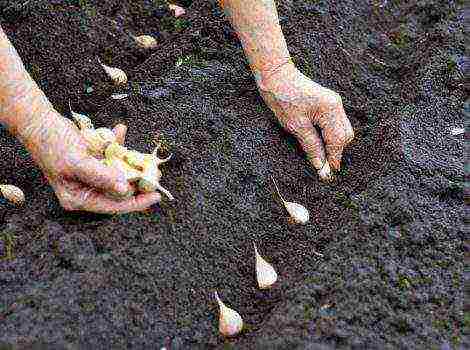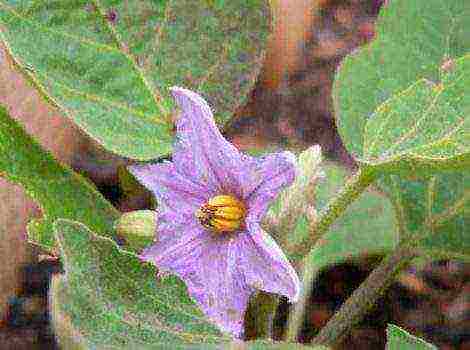9 popular types and varieties of cabbage
When choosing seeds or seedlings of cabbage for growing on their site, many gardeners prefer the white-headed variety. This limitation is rather due to the disappointment experienced with the failed cultivation of other species.
Varieties of cabbage
Undoubtedly, each type of culture is endowed with its own advantages and characteristics of agricultural technology. Although the composition has slight differences, but each variety is rich in useful minerals and vitamins regardless of size and aging period. On the same bed, you can grow cauliflower, broccoli and, for example, kohlrabi, thereby diversifying the menu, winter preparations.
Red cabbage has the largest amount of vitamin C and carotene, and cauliflower is famous for its dietary qualities and excellent delicate taste. It is especially useful to eat vegetables, which increase the body's resistance to radiation and unfavorable environmental conditions. These doctors include broccoli with small heads of cabbage, which was previously considered exotic. Modern gardeners successfully grow a rather unpretentious vegetable in their beds, collecting generous harvests from them.
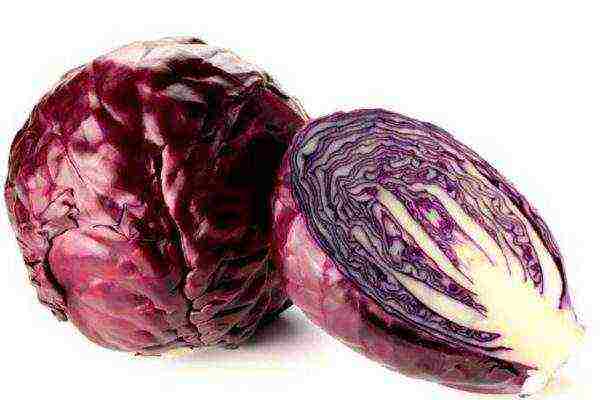
Redhead, pure purple vitamin
It should have justly been called violet-headed. Outwardly, the red-headed look is similar to the white one, but the leaves are red-purple in color, more dense in structure. The composition is also superior in the content of valuable minerals and vitamins, their number. Leaves from the head can be plucked as early as June for making salads. The vegetable is used in pickled and stewed form, both as an independent product and in combination with other ingredients.
The growing season of the red-headed species lasts from 150 days, the head weight on average weighs 1-3.5 kg. Among the main advantages:
- cold resistance (young shoots tolerate frosts up to minus 5 ° C);
- the root system is well developed;
- the composition includes anthocyanin, which has a positive effect on human health (increases the elasticity of capillaries, regulates their permeability).
There is only one drawback of this species - it is the impossibility of using it for fermentation.
Cauliflower
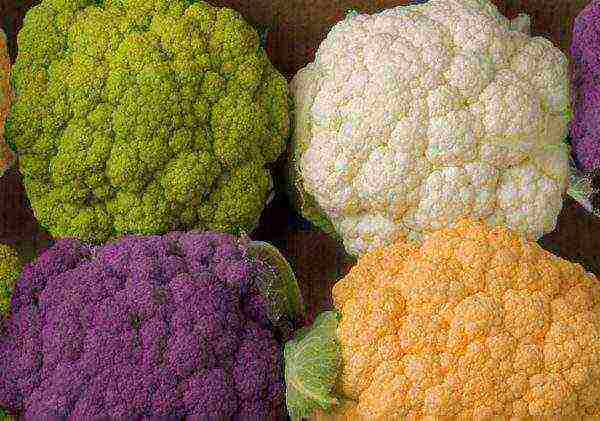
Justifies the name: fruits come in all colors of the rainbow. A popular vegetable on the site for many gardeners and an equally well-known product among culinary specialists. Vitamin Bomb is eaten both as an independent ingredient and in combination with other ingredients. The growing process does not involve complex procedures and does not require much attention. One has only to follow the elementary rules of agricultural technology.
The annual plant forms dense inflorescences weighing from 350 to 1500 kg. Soil fertility and growing conditions affect the palatability of the fruit. Harvesting is done 90-105 days after sprouting (early ripening varieties).
Broccoli, characteristic

The vegetable is similar to cauliflower, but the inflorescences have a rich green color.The richest composition of proteins and vitamins raised this species to the category of popular crops. Anti-aging cabbage delicacy, many gardeners are trying to cultivate on their plots. This is facilitated by unpretentious agricultural technology and cold resistance of cabbage, it does not lose its qualities when freezing to minus 7 ° C. Unlike other species, the culture is undemanding to soil fertility, but this does not mean that the plants do not need fertilization, some kind of feeding is still needed. Regular watering is also necessary, especially when the heads are ripening.
Benefits of growing broccoli:
- usefulness and nutritional value of the product;
- the ability to diversify the menu;
- unpretentious care during cultivation;
- the vegetable is subjected to various types of processing (stewing, salting, etc.).
The lack of features of agricultural technology deprives the vegetable of its shortcomings.
Savoy

Ideal vegetable for growing in the middle lane. Savoy cabbage is resistant to drought, it is not interesting to pests. In structure, the vegetable is similar to the white-headed species, however, the leaves are more tender and airy. They are easy to disassemble for cooking different dishes, you just have to pour boiling water over them. The composition contains a large amount of valuable minerals and vitamins, exceeding the amount of other types.
The vegetative period of early varieties lasts 105-120 days, hence the low yield. The taste of the vegetable is very delicate due to the small amount of mustard oils in the composition and the absence of coarse fibers. Suitable for fresh, stewed consumption. The peculiarity of the species is cold resistance, with short frosts it retains its marketable and taste qualities.
A short shelf life is considered a disadvantage.
Kohlrabi, health grade
The chemical composition of kohlrabi is comparable to citrus crops, so the vegetable is very popular among cooks. Gardeners are less willing to use the crop for growing on their plots. And in vain, because the fruits have a beneficial effect on the cardiovascular system, stabilize blood pressure, cleanse the intestines of toxins.
The ripening period of early varieties is 65-80 days. The stem fruit reaches a mass of 220 grams, some varieties weigh over 2 kg. The short growing season allows for several harvests per season. You can cultivate a vegetable in the open field and in greenhouses. Plant care is generally similar to other types of cabbage. The crop is stored for a long time without any loss of valuable properties.
Brussels, small heads of cabbage

The rarest type of cabbage in our beds. The composition contains a whole storehouse of vitamins and trace elements, exceeding the number of white-headed varieties. A special feature of the vegetable is the presence of mustard oil, which is characteristic of radish. This component gives the product a nutty flavor.
The main advantage of crop cultivation is the unpretentiousness of plants to the climate of the middle zone. The main disadvantage is the long growing season.... When planting seeds in April, you can get a crop only at the end of the warm season (ripening period is about 150 days). To speed up the process, it is recommended to grow the vegetable through seedlings.
Beijing, not afraid of frost
In Russian vegetable growing, the cultivation of Peking cabbage is only gaining momentum. The vegetable gained popularity due to its rich vitamin composition, interesting taste and high yield (900 centners are removed from 1 hectare). The plant grows in conditions of low temperatures, which is typical for the climate of the middle zone. The growing season lasts only 50-70 days, which gives the ability to get 2-3 harvests per season... You can grow crops both in the open field and in greenhouses all year round.
Cabbage benefits:
- composition rich in useful substances;
- young shoots can withstand short-term frosts up to minus 7 ° С;
- high productivity.
The culture is not devoid of cons:
- yield depends on soil fertility;
- agricultural technology has not been fully studied;
- the vegetable attracts the attention of pests, is vulnerable to disease.

Marine, from the bottom of the sea
The product is unique in its qualities and effect on the human body. The complex biochemical composition is characterized primarily by the content of iodine, a necessary substance for the thyroid gland. In addition to it, kelp are rich in vitamins B, C, folic acid, amino acids, pantothenic acid and other microelements. In fact it is an alga that grows on the seabed... With any type of processing (pickling, drying), cabbage retains its valuable properties. It can harm health only if a person has an increased sensitivity to iodine.
Chinese, source of longevity
In terms of composition, Chinese cabbage is very similar to white cabbage, but differs significantly in appearance. The leaf formation of a vegetable without a head ovary is more reminiscent of lettuce, but with a richer green color. Lysine, an amino acid that cleanses the body of toxins and other harmful substances, is of particular value.
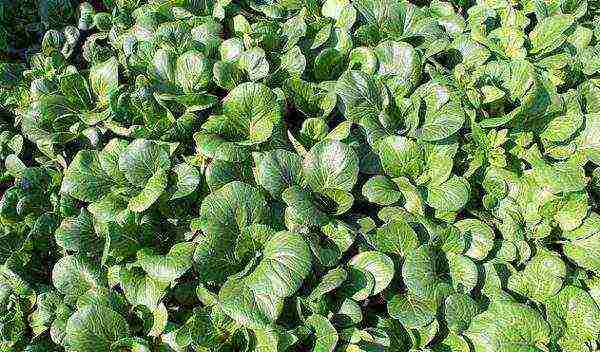
Chinese vegetable high appreciated not only for taste, but also for the ability to strengthen the immune system, which is necessary for longevity... Among the indisputable advantages:
- harvesting in June, which is useful for replenishing vitamin deficiencies in the body;
- delicate leaf structure, can be used for baby food;
- simple rules of agricultural technology.
There is only one minus - the large size of the stalk, which takes up almost half of the vegetable. But you can also use it for cooking.
You can eat fresh leaves, pickled, stewed and dried. After the onset of cold weather, the pots with the culture can be placed indoors and harvest until December.
The assortment of cabbage in the beds will make it possible to enrich the body with useful microelements, strengthen the immune system and diversify the menu with delicious dishes.
